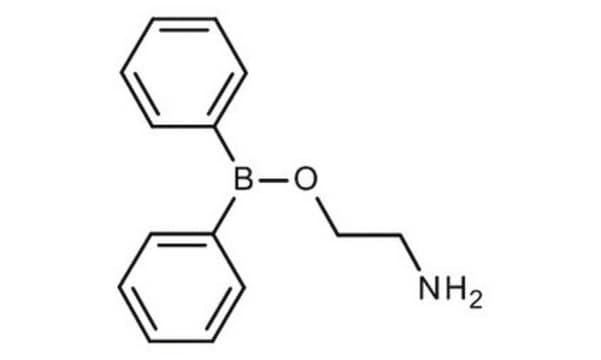100065
2-APB
≥97% (titration), crystalline solid, Ins(1,4,5)P3-induced Ca2+ release inhibitor, Calbiochem®
Synonym(s):
2-APB, 2-Aminoethoxydiphenylborate, (2-Aminoethoxy)diphenylborane
About This Item
Recommended Products
product name
2-APB, A cell-permeable modulator of Ins(1,4,5)P3-induced Ca2+ release.
Quality Level
Assay
≥97% (titration)
form
crystalline solid
manufacturer/tradename
Calbiochem®
storage condition
OK to freeze
desiccated (hygroscopic)
color
white
solubility
DMSO: 20 mg/mL
95% ethanol: 25 mg/mL
shipped in
ambient
storage temp.
2-8°C
InChI
1S/C14H16BNO/c16-11-12-17-15(13-7-3-1-4-8-13)14-9-5-2-6-10-14/h1-10H,11-12,16H2
InChI key
BLZVCIGGICSWIG-UHFFFAOYSA-N
General description
Biochem/physiol Actions
Ins(1,4,5)P3-induced Ca2+ release
Packaging
Warning
Reconstitution
Other Notes
Gregory, R.B., et al. 2001. Biochem. J.354, 285.
Ma, H.T., et al. 2001. J. Biol. Chem.276, 18888.
Ascher-Landsberg, S., et al. 1999. Biochem. Biophys. Res. Commun.264, 979.
Maruyama, T., et al. 1997. J. Biochem.122, 498.
Legal Information
Signal Word
Warning
Hazard Statements
Precautionary Statements
Hazard Classifications
Eye Irrit. 2 - Skin Irrit. 2 - STOT SE 3
Target Organs
Respiratory system
Storage Class Code
11 - Combustible Solids
WGK
WGK 3
Flash Point(F)
Not applicable
Flash Point(C)
Not applicable
Certificates of Analysis (COA)
Search for Certificates of Analysis (COA) by entering the products Lot/Batch Number. Lot and Batch Numbers can be found on a product’s label following the words ‘Lot’ or ‘Batch’.
Already Own This Product?
Find documentation for the products that you have recently purchased in the Document Library.
Customers Also Viewed
Our team of scientists has experience in all areas of research including Life Science, Material Science, Chemical Synthesis, Chromatography, Analytical and many others.
Contact Technical Service
















